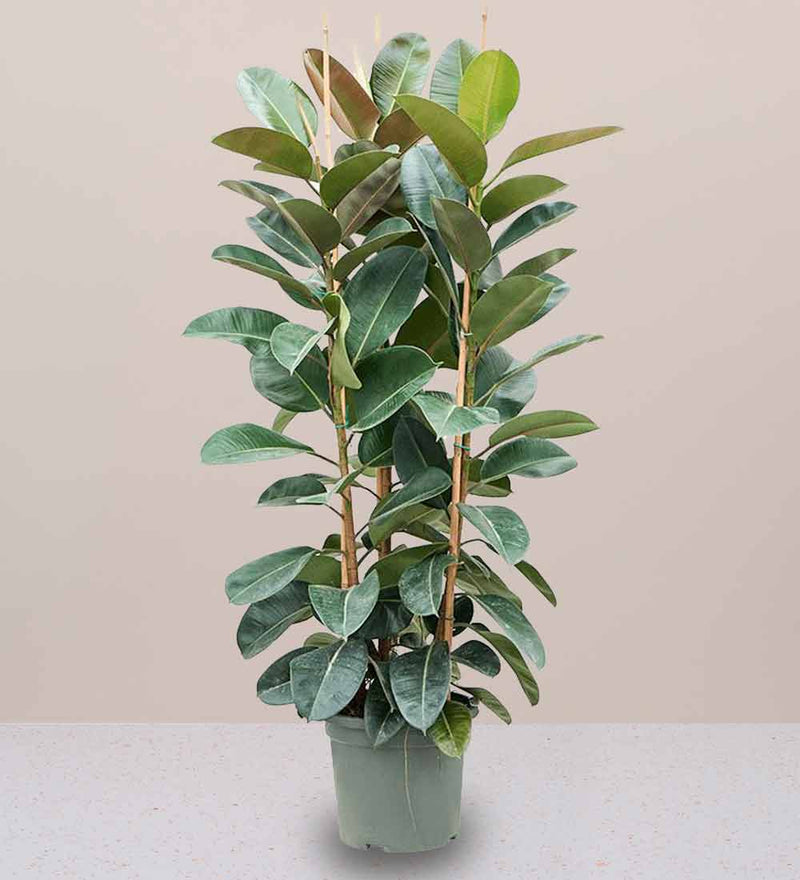Rubber Plant / Ficus Elastica Tall 3pp 1.2 to 1.5m
Free returns on all eligible orders
You have 7 days to request a return. All sale items are final sale.
The Rubber Plant (Ficus elastica) is a striking and popular houseplant known for its glossy, broad leaves and impressive size. Here's a quick guide to help you understand and care for it:
🌿 Overview
-
Scientific name: Ficus elastica
-
Common names: Rubber tree, rubber fig, Indian rubber bush
-
Origin: Native to South and Southeast Asia; naturalized in places like Sri Lanka, Florida, and the West Indies
🌱 Appearance
-
Grows up to 100 feet in the wild, but typically 6–10 feet indoors
-
Leaves are oval-shaped, shiny, and range from green to burgundy depending on the variety
-
New leaves emerge from a colorful sheath and unfurl dramatically.
🏡 Indoor Care Tips
-
Light: Prefers bright, indirect sunlight
-
Water: Keep soil moist but not soggy; allow topsoil to dry slightly between waterings
-
Humidity: Thrives in moderate humidity; misting can help
-
Temperature: Ideal range is 15–28°C
-
Soil: Well-draining, fertile potting mix
-
Feeding: Monthly during growing season (spring and summer)
-
Toxicity: Sap is toxic to pets and can irritate skin.
🌸 Varieties to Explore
Here are a few stunning cultivars:
-
‘Decora’ – Emerald green leaves with bronze new growth
-
‘Robusta’ – Compact with purplish-green leaves
-
‘Burgundy’ – Deep red to nearly black leaves
-
‘Tineke’ – Variegated with cream and green patches
Comprehensive Overview:
The Rubber Plant (Ficus elastica), also known as the Rubber Tree, is a popular indoor plant that belongs to the fig family (Moraceae). It is valued for its attractive, broad, glossy leaves and its ability to adapt to a variety of indoor conditions. Here's a description and care guide for the Rubber Plant:
Ficus elastica "Abidjan" or Rubber Plant is variety of rubber plant has dark green leaves with a hint of Burgundy. It absorbs toxins and a great plant for improving the environment in both homes and offices. Ficus elastica 'Abidjan' is easy to look after and avoid direct sunlight.
Suitable for low-light situations but can also tolerate natural indirect light. It produces a white, sticky, milky sap when cut. Hence the name 'rubber plant'. This is slightly toxic.
Temperature: Average room temperatures of 60 - 75°F (15 - 24°C are fine. Avoid lower than 55°F (12°C), sudden temperature drops and cold drafts.
Light: A nice brightly lit spot is ideal, without direct sunlight.
Watering: Water once the soil becomes slightly dry to the touch and make sure the pot has sufficient drainage holes to allow excess water to seep through. The worst thing you can do regarding watering is "give it too much".
Soil: A well-draining and well-aerated potting soil is needed. 1 part peat, 1 part pine bark, and 1 part coarse sand (or perlite) is a good mix.

